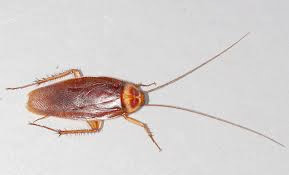ManageSafe™
Least-Toxic Control of Cockroaches Choose a different pests

|
Factsheet: Least-toxic Control of Cockroaches, Good Riddance to Roaches
Identification
Pest type: Insects
There are a range of different roach species around the world, that are defined, in part by there affinity to certain habitat. The Australian roach is more vegetarian than other species, and may be found in greenhouses. The American roach enjoys moisture and life on the seas -- it is common on ships, as well as in basements and sewers. The smokybrown roach also can be found in sewers, but primarily lives outdoors. Oriental roaches are also moisture lovers, while the brownbanded roaches prefer warm, dry environments, such as closet shelves and the upper stories of houses.
German roaches have the widest distribution of all domestic roaches and are often found in dead leaves and garbage piles, but also readily invade cartons, sacks and containers, and will enter empty or open bottles. They invade the indoors from outdoor habitats in the summer only, and are usually found in basements and on first floors, having a preference for the warm area around furnaces and heating ducts. This is the most common roach to be seen in food preparation areas in restaurants, cafeterias and kitchens – environments where the combination of food, moisture and warm temperatures mimic that of their native East Africa.
This roach prefers squeezing into small cracks where their backs and undersides make contact with other surfaces. They are often found backed into cracks with their antennae and heads sticking out, picking up chemical signals from the air, which their behavior is more dependent upon than vision or sound. They become more active 20 minutes to 2 hours before dark, and increase their activity to a peak ending before daybreak. Only when populations are very high will they be active during daylight.
Is it a problem?
Cockroaches have many negative consequences for human health because certain proteins (called allergens) found in cockroach feces, saliva and body parts can cause allergic reactions or trigger asthma symptoms. Asthma is a serious, sometimes life-threatening chronic respiratory disease that millions of Americans suffer from.
Cockroaches can also passively transport microbes on their body surfaces including pathogens that are potentially dangerous to humans. Cockroaches have been implicated in the spread of 33 kinds of bacteria, including E. coli and Salmonella, six parasitic worms, and more than seven other types of human pathogens.
Pest prevention practices
Remove food sources
Dispose of trash
Place trash in sealed containers
Store food in air-tight, sealed containers
Remove potential habitat
Remove clutter
Caulk, weather-strip, and repair any holes larger than 1/16” around water pipes, baseboards, electrical fixtures, outlets, switches, doors and windows.
Screen over windows, vents, floor and sink drains, and ducts.
Keep trash, leaf piles and woodpiles away from the building.
Fix leaky faucets and drains. Insulate pipes to prevent condensation.
Eliminate newspapers, magazines and paper bags.
Inspect all food brought into the building.
Store food in tightly sealed containers or in the refrigerator and put pet food away overnight.
Clean all spills immediately, wipe all counters and tables after use, and keep the stove grease and food free.
Rinse food and drink containers before disposal, empty trash and recycling frequently, use trash cans with tight- fitting lids and avoid placing them under sinks.
Avoid soaking dishes overnight, place sponges and dishrags in an airtight container, and avoid overwatering plants.
Monitoring and record-keeping
Once a month, place two sticky traps per room where roaches would be traveling (where floor meets wall or countertop, inside cupboards, under sink, behind appliances) and leave them for 24 hours.
Non-chemical and mechanical controls
Repair holes
Create a barrier
Sticky traps
Remove water source: check drains, faucets and pipes
Remove clutter
Vacuum
Handpick and destroy
In-Depth Information:
An upright, baited pint jar will trap cockroaches if the jar is placed where the roaches are likely to find it. A 2-inch wide band of petroleum jelly on the inside lip of the jar will prevent trapped roaches from escaping. Kill the insects by dropping them into hot water. Bait the jar with apples or potatoes. Banana peels are most attractive to German cockroaches. Change the bait frequently. If no roaches are trapped in 2 to 3 days, move the traps. Commercial traps are also available.
Biological controls
Biological controls are not effective at controlling indoor cockroaches.
Least-toxic chemical options as a last resort
Boric acid is the most effective direct control method. Apply boric acid (a 99% formulation) to cracks and crevices where roaches hide – inside and behind cabinets and appliances, wall cavities, under the sink, etc. Roaches are killed in three to ten days. Alternatively, baiting gels and bait stations that contain boric acid are very effective, but make sure the inert ingedients are listed.
Dessicating dust, such as diatomaceous earth or silica gel can be blown into voids through small holes drilled into the walls. Be sure to choose a dust that is not mixed with pyrethrins. Dusts placed in wall voids or cracks and sealed can be effective for many years if they are kept dry.
Chemicals to Avoid
Look at your product labels and try to avoid products containing those chemicals listed below:
(A = acute health effects, C = chronic health effects, SW = surface water contaminant, GW = ground water contaminant, W = wildlife poison, B = bee poison, LT = long-range transport)
|
Abamectin/Avermectin B1 Acephate Acetamiprid Allethrin Carbaryl Chlorpyrifos Clothianidin Cyfluthrin | Cypermethrin Deltamethrin Dichlorvos (DDVP) Esfenvalerate Fipronil Hydramethylnon Imidacloprid Indoxacarb | Malathion Methoprene Naled Permethrin Prallethrin Propetamphos Propoxur Pyrethrins | Pyriproxyfen Resmethrin Tetramethrin Thiamethoxam Tralomethrin |
Social Media
See what other folks are saying about this, and let us know what works for you.
Containing Cockroaches: Welcome Back to Question of the Week! Question:I live in a basement apartment, and I’ve been...
Posted by Beyond Pesticides on Friday, January 29, 2016
Click the post above to view and comment on Facebook, or comment directly on this site below.








